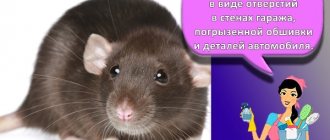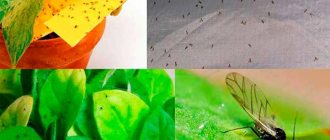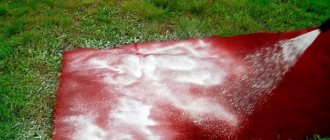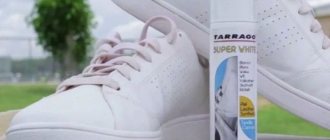Blood-sucking parasites that have settled on a pet cause a lot of trouble for both it and its owner. Considering that parasites multiply quickly and can cause the development of serious diseases, you need to get rid of fleas on a cat as soon as possible.
Veterinary pharmacies offer a wide range of products suitable for these purposes.
What are fleas on dogs and cats
Fleas are small, wingless, blood-sucking insects. The lack of the ability to fly is compensated by very developed legs, due to which they are able to cover distances of up to 1 meter in length and 1.5 in height.
Fleas live up to two months.
Their development cycle consists of eggs, larvae, pupae and adults. Contrary to popular belief, fleas do not live on animals. We can say that our pets are just a “dining table” for them. The time they spend feeding ranges from 1 minute to several hours, so it is not always possible to notice the insect during the meal. Adults feed on the blood of mammals and birds, and attack based on the level of carbon dioxide and vibration, so they rarely attack humans, usually when there is absolutely nothing to eat, we are “not tasty” for them, and besides, we have quite thick skin, which is not so just bite through. After feeding, sexually mature adults lay eggs on the animals' fur, which eventually fall off and fall anywhere. The eggs hatch into larvae, which after several molts turn into pupae. During this period of development, they hide in the cracks of houses, under baseboards, in the carpets and bedding of our apartments, that is, where it is “dark and not visible” and feed on digested blood (the excrement of adult individuals).
In the wild, these are bird nests and animal burrows. Their population, under proper conditions and sufficient food, grows rapidly. According to statistics, only 5% of the population are adult insects, the remaining 95% are eggs, larvae and pupae. During the winter, they do not die out or hibernate, but spend the winter well in basements in the entrances of houses.
That is why it is necessary to carry out treatment throughout the year, and not just in the summer. And therefore, the cat does not have to go outside at all, the fleas will come to her themselves!
Causes and signs of infection
Absolutely any cat can become infected with fleas, regardless of their habitat and lifestyle. And the point is not in poor care or inattention of the owner, but in the fact that parasites can lie in wait for an animal anywhere - both at home and on the street. You can catch fleas:
- while walking;
- upon contact with an infected animal;
- in an apartment where fleas can get in, for example, on a person’s shoes or clothes, or from the basement of a house.
Upon contact
It is not difficult to understand that a cat has parasites. There are several obvious signs of infection:
- behavior changes - the animal becomes nervous, restless, itches frequently and furiously;
- appetite worsens;
- shallow, restless sleep;
- wounds from constant scratching are visible on the skin, as well as small dark spots - flea excrement.
In addition, if a cat has a lot of fleas, then you can see them with the naked eye, you just need to slightly move the pet’s fur.
How to find out if a cat or dog has fleas?
Sometimes you can see adult insects on the skin.
And this process is called flea infestation. In some cases, you can find small black dots on cats' fur; these are flea experiments. If they are placed on damp white paper, they will soon spread, leaving a red-brown mark. This study is called the wet paper test.
But it is not always possible to identify fleas in a cat using this method, since cats spend a lot of time grooming and simply lick off traces of parasite activity with their tongues.
It can also be difficult to detect fleas on a dog, especially in thick fur. The wet paper test can also be useful in this case.
Effective folk anti-flea remedies
Removing fleas at home using folk remedies is a labor-intensive and sometimes lengthy process. The vast majority of products have a repellent effect that lasts as long as the fur retains the smell of the components of the tincture, shampoo, etc. There are a number of proven and effective recipes that can successfully combat annoying insects. Folk remedies for fleas in cats include wormwood, garlic, essential oils and other remedies.
Herbs for fleas
Wormwood against parasites
Wormwood for fleas is one of the most popular folk remedies for fleas in kittens and cats. Its smell repels not only fleas, but also other blood-sucking parasites. The advantage of wormwood-based preparations is their safety. Wormwood can be used as a remedy for fleas in kittens and without worrying about the health of the mother cat, who will lick her offspring.
- 20 g of dry or 40 g of fresh wormwood leaves, pour 500 mg of water and bring to a boil, cook for 15-20 minutes. Strain the resulting mixture, cool and anoint all parts of the animal’s body. You must be prepared for the fact that during treatment insects will begin to actively jump off the cat. Treat your pet as needed.
- Wormwood tincture will help get rid of fleas. To prepare it you will need: wormwood, lavender, tansy, eucalyptus, 10 g of each ingredient and one liter of water. Boil the mixture, strain and cool. Apply the prepared decoction to the animal itself and all its accessories. The course of treatment is 7-10 days.
“When fleas appeared on two-month-old kittens, we were scared, because chemicals cannot be used: the kittens are constantly licked by their mother. We found a recipe for wormwood tincture on the Internet, and after a week there were no more fleas!”
Vinegar for fleas
Using vinegar is a very radical measure, but this barbaric method can quickly remove parasites. Mix vinegar, ammonia and any floral cologne in equal proportions. Pour the resulting substance into a spray bottle and treat the animal’s fur. Then “pack” the cat in a plastic bag, leaving the head outside. Keep your pet in this state for 7-10 minutes, then bathe it and thoroughly comb its fur to remove all dead fleas. This folk remedy for fleas in cats is suitable only for the most patient pets.
Vinegar, salt and garlic
Garlic for fleas
The smell of garlic will provoke fleas to panic flight from their place of deployment. To prepare garlic tincture, chop 6-7 large cloves of garlic using a squeezer and add 3-4 glasses of water at room temperature. Let it brew for 12 hours. You can add a few teaspoons of brewer's yeast to the tincture. Wipe the cat's fur with the prepared extract, mainly in places where it cannot reach. Garlic should not be allowed to enter the animal’s digestive tract to avoid digestive disorders and poisoning.
Salt remedies for cat fleas
Dilute 1 kg of ordinary table salt with a small amount of water and completely dissolve it; to facilitate the process, you can boil the solution. Then dilute this entire mixture with 10 liters of warm water and wash the animal in it for 5-7 minutes so that all the fur is saturated with the saline solution. After this, bathe the meowing lump in warm water. This method of removing parasites is also suitable for small kittens.
Anti-flea shampoo recipe
Grind or grate a third of regular baby soap, add 3 cups of water and simmer over low heat until the mixture becomes a jelly-like substance. Allow time to cool, then add one chopped onion, the yolk of one egg and a spoonful of nettle infusion. Lather your pet with shampoo and rinse off after 15-20 minutes.
“Our cat has negative skin reactions to chemical medications, so we decided to get rid of fleas using folk remedies. We made shampoo from soap, onions, eggs and nettles. The smell was not very pleasant, but our pet endured the treatment with dignity. The fleas didn't appear right away, but they disappeared! Of course, we also treated her bedding and apartment.”
Geranium decoction
Pour 30 g of geranium and 30 g of lavender into 3 glasses of water and cook for 15-20 minutes. Bathe your cat in the filtered infusion and make sure that the product does not get into the ears or eyes.
Citrus fruits against parasites
Unlike many others, the product has a pleasant smell. Cut one lemon and pour 2 glasses of warm water over it, leave for 24 hours in a dark place. Spray the pet with the finished product from a spray bottle.
“When our cat got fleas, we decided to use lemon. But our pet didn’t like the smell, so we had to use a special product from the pharmacy, which did its job perfectly!”
Essential oils to protect cats from fleas
Essential oils are among the safest folk remedies. Oils of cedar, lavender, rosemary, geranium, mint and lemon have proven themselves well. To spray an animal, 2-3 drops per 3 glasses of water are enough. Oils are added to shampoos and applied to the collar.
Tea tree essential oil should not be used to treat cats for fleas. The smell of oil causes vomiting, weakness, and dizziness in the animal.
The main symptoms of fleas in cats and dogs
Insect bites often cause allergies in animals and fleas are no exception.
Just like people, not every pet is hypersensitive to flea bites. That is, among several cats living in one apartment infested with fleas, only one may itch. The allergy develops to flea saliva protein and has the following manifestations in cats: restlessness, itching in the head, back, tail, thighs, alopecia, miliary dermatitis, eosinophilic granuloma complex.
In dogs: anxiety, itching in the back, thighs, tail, alopecia, erythema, pyoderma; less often - otitis, pododermatitis. But, unfortunately, the lesions are not always so specific.
Flea saliva remains in the skin for up to several weeks, so a pet bitten by the parasite may itch for quite a long time.
Pest injections
When treating cats, you can use injections. Suitable for this;
- Ivermectin;
- Eprimek;
- Lufenuron.
They will help protect the animal from harmful insects for a long time. The action lasts approximately six months. But there are also contraindications. It is necessary that the injections are given by a veterinarian.
Infections transmitted through fleas
These parasites are quite dangerous for animals in that they can be carriers of such dangerous diseases as hemobartonosis of cats and dipylidiasis of carnivores.
Hemobartonosis is a disease caused by mycoplasmas, also known as feline infectious anemia. Mycoplasmas cause massive death of erythrocytes (red blood cells), which leads to severe anemia and hypoxia, as a result of which the cat can even die!
Dipylidia is a parasitic disease caused by the tapeworm, also known as the cucumber tapeworm because its segments resemble cucumber seeds.
Adult dipylidia live in the small intestine, causing gastrointestinal dysfunction (diarrhea, abdominal pain, etc.) in the host.
Dogs and cats become infected through a flea bite. There are only two diseases in humans caused by the bites of these insects: pulicosis and sarcopsylosis . In addition, bites can transmit more than twenty infections dangerous to humans, including the bubonic plague, which killed half of Europe in the Middle Ages.
Preventive treatment of the premises
To get rid of fleas on a full scale, you need to pay attention to treating the apartment. Fleas cannot tolerate the smell of tree resin. Therefore, pine shavings and sawdust can be used as animal bedding filler. It would be a good idea to pre-wash it in pine extract and throw it out in the cold at least overnight. It repels ground fleas and animals well with bunches of herbs (wormwood, mint, lavender). They are placed in corners, near baseboards, under the bed, under a dog or cat’s bedding, or in an animal’s house.
A homemade composition applied with a spray bottle will help save plants from fleas.
The composition of salt and soda (100 g each) does not repel, but rather destroys fleas. Sprinkle the powdered product generously and rub it into all surfaces, especially in the crevices of the floor. It is necessary to treat toys, carpets, and upholstery. Leave for 24 hours, then use a vacuum cleaner to carefully collect the mixture along with dead or half-dead fleas, their eggs and larvae.
Rosemary, lavender, wormwood, thyme, and pine branches can be kept in the house constantly and changed as needed. On the one hand, this is a kind of aromatherapy, on the other hand, it is the prevention of uninvited jumping “guests” from entering your territory.
Check out articles on similar topics
- How to rid your dog of fleas
- How to get rid of cat fleas in an apartment
- How to remove earthen fleas from an apartment or house
- How to get rid of genital fleas
Comments
- Varvara
We also use Vectra 3D for quite a long time, it’s a good product, it doesn’t work through a bite - this is very important for me. It contains permethrin - these substances protect against all types of ticks and other flying parasites. I prefer to treat the dog and not be afraid for it.
29.08.2016
Answer
leave a comment
How to cure fleas in cats and dogs?
First, it is necessary to treat all animals in the house.
Secondly, be sure to treat the room (floors, baseboards, cracks), resting areas for cats and dogs, and a rug at the front door.
What is important to consider when choosing a drug to treat your pet?
- Age (not all drugs can be used at an early age)
- Type of animal (some substances can be deadly to pets. For example, permethrins are deadly to cats, and fipronil to rabbits!)
- Breed (some substances may be harmful to dogs with the MDR-1 gene mutation)
- Weight. Absolutely all drugs are prescribed based on the amount of active substance per animal weight. Drops for large dogs should not be used for medium and small breeds due to the risk of overdose, and the use of drops for small breeds will simply be ineffective for small breeds. Dividing one large dropper into several small dogs will also not give the desired effect due to the number of hair follicles where the droplets accumulate.
How to remove fleas from your home
To get rid of parasites in your home:
- First, wash the floor with a solution containing soap, alcohol, lavender or peppermint oil. Such strong odors will repel parasites.
Washing the floor with aromatic additives is a procedure that no parasite can withstand - Wash the walls and baseboards with the same solution. Keep in mind that fleas can rise to a height of up to a meter from the floor.
Be sure to wear rubber gloves when cleaning - Wash clothes, bedding, carpets, furniture covers and pet bedding.
Washing bedding and towels is an important step that will allow you to get rid of parasites forever - Take pillows, blankets and mattresses outside. Parasites cannot stand heat, cold and sunlight, so they will immediately run away from their homes.
- After the general cleaning is completed, place bunches of tansy, mint, wormwood or spruce branches in all corners.
The safest thing to do in your case is to use regular cleaning and a steamer, which will reduce the number of fleas.
Sergey
https://vetdoc.in.ua/kak-unichtozhit-blox-v-kvartire-sovety-veterinara.htm
in order not to harm yourself, use physical control measures - high temperature, if there is no steamer, you can use an iron with a steaming function to process the mattress; if the fabrics are natural, then you can simply iron them with an iron, there will still be a positive effect.
But treatments need to be done regularly - once a week. 2. When frosts begin, you can take the mattresses outside, if possible. Sergey
https://vetdoc.in.ua/kak-unichtozhit-blox-v-kvartire-sovety-veterinara.htm
Flea medications
Effective and safe medications for pets are produced in the form of drops on the withers: Stronghold, Advocate, Frontline, Broadline, Prak-tik and Simparica tablets, Nexgard Spectra, Bravecto (for cats Bravecto in the form of drops).
The drops must be applied to the animal’s withers in several places; dogs over 25 kg are treated at the withers and along the spine. The active substance of the drops is absorbed into the subcutaneous fat and blood, and also accumulates in the hair follicles and sebaceous glands. It is important to remember that when using drops, you should not wash your pet two days before and after treatment.
Many of the modern drugs also act on ticks and worms in particular. Some medications are approved for pregnant dogs and cats, for example, Stronghold. They are absolutely safe and act exclusively on parasites without causing harm to our pets.
Sprays are quite effective when applied correctly and based on body weight. It is good to treat animals with them immediately before a walk.
Collars do not always provide as good protection as drops or tablets. It is important to remember that the collar must fit tightly to the surface of the skin, so it will not be effective on pets with thick and long hair.
Anti-flea shampoos can be used, but you need to understand that they only work during washing.
Natural drops and collars with lavender and essential oils are not effective at all. A hungry flea will not pay attention to their pungent odor.
General recommendations
You can cure your pet of parasites, but you cannot protect against new ones. You can remove these creatures from the apartment, but your baby’s “friends” may also have fleas. Your apartment is also not protected from the appearance of fleas from the basement or from your neighbors. In general, outside the apartment they can be anywhere.
Inspect your pet more often, especially the tummy, as it is easy to spot such pests there.
You can get rid of these parasites. All you have to do is go to a pet store. Domestic manufacturers have developed many special flea shampoos . But you shouldn’t so carelessly believe everything that’s written on the label. In addition, your baby can also be poisoned by this shampoo when he washes his fur. Better caress the fur of your beloved pet.
There are special drops that are very effective in removing fleas. You need to drop a few drops in a place inaccessible to your pet (for example, at the withers). These drops have one peculiarity: they very quickly penetrate the blood and poison it for parasites. All deposited larvae also die. The action of the drops lasts for a very long time. But after applying the drops, the animal needs to be washed a few hours later.
The safest of all means are special flea collars. They are impregnated with some composition of chemical elements. But not all elements are beneficial for animals; allergies may occur.
You can also find anti-parasite spray in the pet store. It is as effective as drops. It will rid your pet of fleas and protect at some distance.
The apartment needs thorough cleaning with special cleaning products. Fleas may reappear in your home, but the product you treat your pet with will protect him for a while.











